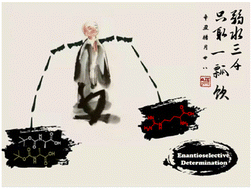Enantioselective determination of chiral acids and amino acids by chiral receptors with aggregation-induced emissions†
Abstract
Enantioselective recognition is a general process in the natural world, which is involved in asymmetric synthesis, chiral drug separation, food chemistry, and life sciences. Herein, a pair of chiral AIEgens composed of cyanostilbene and optically pure 1,2-diphenylethylenediamine groups were facilely synthesised; the products showed excellent enantioselectivity for a series of chiral acids and amino acids. 1H NMR and 2D-NOESY spectra indicated that the chiral sensing ability could be attributed to the multiple hydrogen-bonding interactions and specific stereoselectivity between the chiral 1,2-diphenylethylenediamine group and the enantiomer of the chiral guest. These synergistic interactions resulted in the selective aggregation of the receptor with one of the enantiomers. Interestingly, the chiral AIEgens thus obtained also presented a high selectivity for arginine from 22 kinds of acidic compounds that could be seen with the naked eye. Our research exhibits great potential for high-throughput analysis of enantiomers by AIE-active chiral receptors.



 Please wait while we load your content...
Please wait while we load your content...